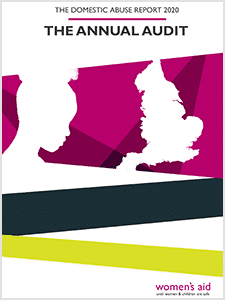The Domestic Abuse Report 2020: The Annual Audit

Every year the Domestic Abuse Report also includes a separate thematic element. The 2020 thematic report will be published later in the year.
© Women’s Aid, March 2020
Please cite this report as:
Women’s Aid (2020) The Domestic Abuse Report 2020: The Annual Audit, Bristol: Women’s Aid.
Key Findings
Demand for all domestic abuse services continues to exceed available provision. This has led to a number of dangerous outcomes, including survivors of domestic abuse being turned away from refuge services, long waiting lists for community-based services, and staff being unable to cope with extremely high workloads.
- 64% of refuge referrals were declined last year
- The number of refuge bed spaces in England is now 30% below the number recommended by the Council of Europe.
- Only 5% of refuge vacancies listed last year could accommodate women with no recourse to public funds, and less than half had the capacity to accept women with more than two children.
- Service providers cited the funding crisis as the biggest issue facing the domestic abuse sector. They identified four key problems: problematic competitive tendering; uncertainty over future funding; funding not covering full costs of delivery; and running an area of work with no dedicated funding.
- Nearly half of the service providers who responded to Women’s Aid Annual Survey 2019 were running an area of work without any dedicated funding. Of this group, 48% ran community-based services (such as outreach, floating support or advocacy) without funding, 37% ran prevention/educational work without funding, 34% ran refuge accommodation without funding and 31% ran therapeutic support services without funding.
- For services running an area of work without any dedicated funding, 74% had to use reserves to cover costs, 36% lost staff as a result of job insecurity, and 32% relied on volunteers to deliver the service.